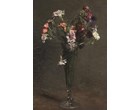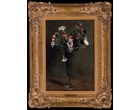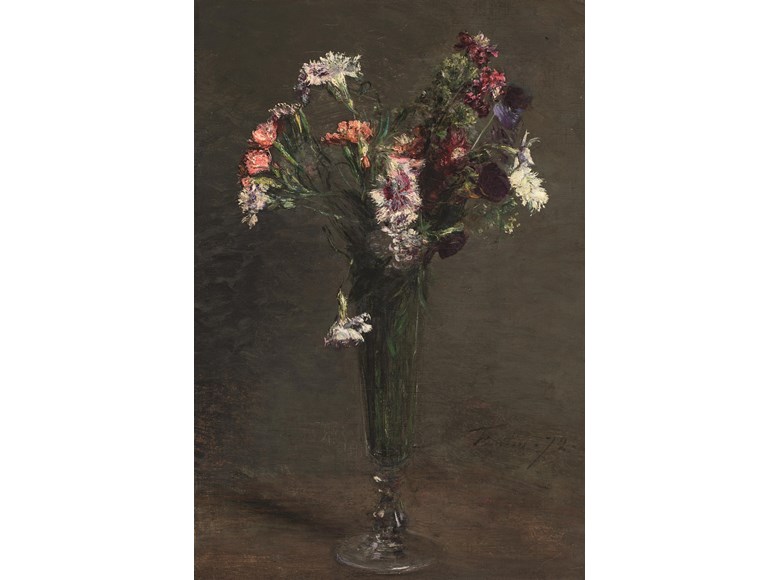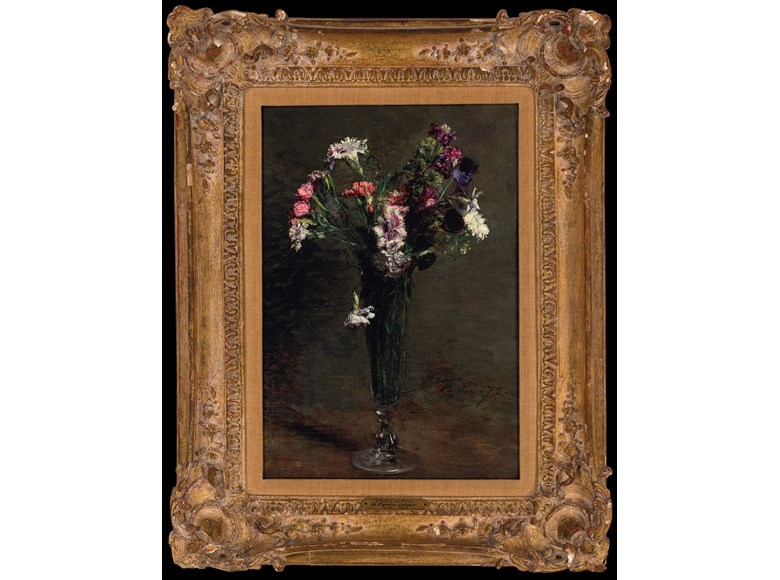 BACK TO GALLERY
BACK TO GALLERY
Avery Galleries
Henri Fantin-Latour
Oeillets dans une flûte à champagne
Signed middle right: Fantin - 72 -
15 1/8 x 10 1/2 inches (38.4 x 26.7 cm)
description
A testament to the measure of Fantin’s reputation in the early decades of the 20th century is that Marcel Proust described his fictional painter Elstir as “the artist who is cited by connoisseurs today as our leading flower-painter, superior to even Fantin-Latour” (trans. A. Mayor and T. Kilmartin, The Past Regained, London, 1981, p. 34). Proust could correctly assume that his readership would have been familiar with Fantin’s stature as the preeminent still-life painter of his time.
Fantin began to paint flowers during the 1860s as a means to secure his livelihood. During a trip to England in 1861, Fantin painted numerous quick sketches of flowers and fruit that delighted his hosts, Ruth and Edwin Edwards. Upon his return to Paris the artist planned to devote more time to painting still-lives, believing that they would prove to be more salable than his portraits. This was a risky venture, for he had to contend with a traditional bias in the Salon that relegated still-life painting to a low rung of the hierarchy of artist’s subjects, but he was encouraged by the acceptance of his still-lives in the 1862 Royal Academy exhibition in London. Edwards acted as his agent, and in the following year the American expatriate painter James McNeill Whistler purchased several of his still-lives and commissioned others for his English clientele. Despite his growing success in London, Fantin was unable to create a French market for his floral subjects. His reputation, nevertheless, spread quietly among a small circle of fellow painters and critics in the Batignolles group associated with Edouard Manet. “In order to reveal this painter’s talent in all its freshness, charm and strength,” the critic Zacherie Astruc wrote in 1863, “one must turn to his flower paintings, so highly regarded in the art world. These are marvels of color and artistic sensibility. They are as compelling as they are charming, in fact one may even call them moving... Their beauty captivates. This is nature with all that fleeting radiance that is the fate of flowers... Delicacy of expression being the essence of his art, Fantin seems to be the visual poet of flowers” (quoted in D. Druick and M. Hoog, Fantin-Latour, exh. cat., National Gallery of Canada, Ottawa, 1983, p. 114). Fantin appreciated how still lives taught the artist “persistence before nature” (quoted in ibid.) and enabled him to understand more clearly the fleeting phenomena of light, color and form in the natural world.
Fantin began to paint flowers during the 1860s as a means to secure his livelihood. During a trip to England in 1861, Fantin painted numerous quick sketches of flowers and fruit that delighted his hosts, Ruth and Edwin Edwards. Upon his return to Paris the artist planned to devote more time to painting still-lives, believing that they would prove to be more salable than his portraits. This was a risky venture, for he had to contend with a traditional bias in the Salon that relegated still-life painting to a low rung of the hierarchy of artist’s subjects, but he was encouraged by the acceptance of his still-lives in the 1862 Royal Academy exhibition in London. Edwards acted as his agent, and in the following year the American expatriate painter James McNeill Whistler purchased several of his still-lives and commissioned others for his English clientele. Despite his growing success in London, Fantin was unable to create a French market for his floral subjects. His reputation, nevertheless, spread quietly among a small circle of fellow painters and critics in the Batignolles group associated with Edouard Manet. “In order to reveal this painter’s talent in all its freshness, charm and strength,” the critic Zacherie Astruc wrote in 1863, “one must turn to his flower paintings, so highly regarded in the art world. These are marvels of color and artistic sensibility. They are as compelling as they are charming, in fact one may even call them moving... Their beauty captivates. This is nature with all that fleeting radiance that is the fate of flowers... Delicacy of expression being the essence of his art, Fantin seems to be the visual poet of flowers” (quoted in D. Druick and M. Hoog, Fantin-Latour, exh. cat., National Gallery of Canada, Ottawa, 1983, p. 114). Fantin appreciated how still lives taught the artist “persistence before nature” (quoted in ibid.) and enabled him to understand more clearly the fleeting phenomena of light, color and form in the natural world.








 SEND AN EMAIL
SEND AN EMAIL
 (610) 896-0680
(610) 896-0680